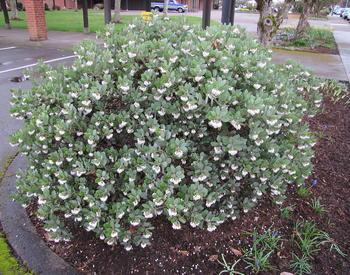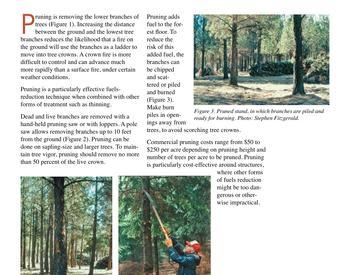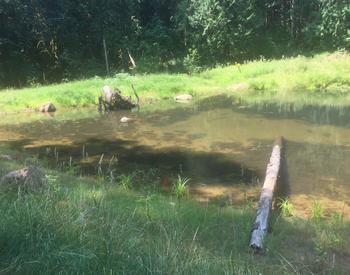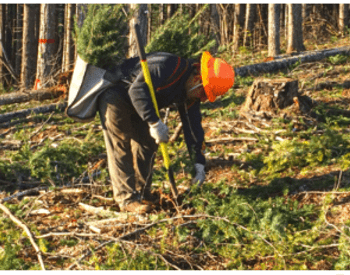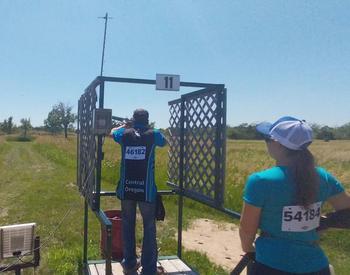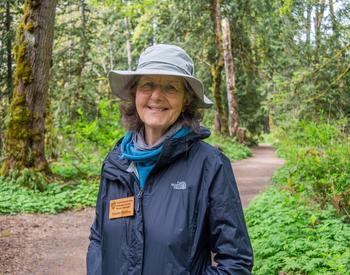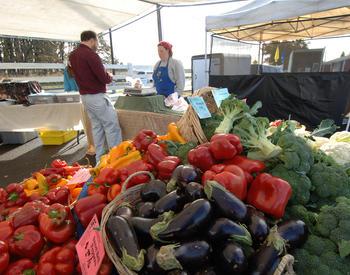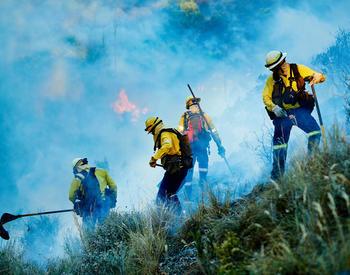Transcript
From the Oregon State University's Extension Service, you are listening to In the Woods with the Forestry and Natural Resources Program. This podcast aims to share the voices of researchers, land managers, and members of the public interested in telling the story about woodlands provide more than just trees.
They provide interconnectedness that is essential to your daily life. Stick around to discover a new topic related to forests on each episode.
Welcome back to the In the Woods Podcast, presented by the Forestry and Natural Resources Extension Program at Oregon State University. I'm Scott Leavengood, extension specialist in wood products, and I have the pleasure this episode of talking with a couple of my colleagues at OSU.
Joining me today are Leeann Mikkelson and Yasmeen Hossain with the Oregon Natural Resources Education Program, which we'll refer to as ONREP from here on out, just to keep it simple. So let's start with introductions. Leeann, tell us a bit about yourself. Well, thank you, Scott. Hello, I'm Leeann Mikkelson. I'm director of ONREP, and I've been taking adults and students outside for over 35 years.
Coasts and beaches, forests and caves, fields and rivers throughout the United States, Virginia, Colorado, Oregon, et cetera. I love facilitating the aha moments of life outside. Ah, yes. And Yasmeen how about you? Yeah, hi everyone. I'm Yasmeen, I'm the Associate Director at ONREP. I've been at Oregon State University for just a little over two years now.
I moved to Oregon during the pandemic, which was a interesting experience as you could imagine. I was born and raised in Switzerland and grew up just in this beautiful, pristine nature, running through endless meadows of wildflowers, climbing these amazing big trees and wading in brooks. And that's really when I fell in love with nature and what started me on my pretty long career in the environmental field.
Wonderful. That does sound delightful. Uh, tell us a little, a little bit about ONREP. Sure. Yeah. So, ONREP as you already mentioned, Scott, is an acronym for the Oregon Natural Resources Education Program. Um, we are part of Oregon State University Extension and Engagement, and we are also a member of the Forestry and Natural Resources extension team.
So at ONREP, we support pre-K to 12 educators with natural resources and environmental education. And the way that we do that, or actually the educators that we support are both formal educators who teach in a conventional classroom, but also the non-formal educators who may be homeschooling or maybe they work at state parks or museums.
Um, sometimes at summer camp leaders or outdoor school staff. So, um, lots of non-formal educators who we support as well. So the way that we support these educators is we provide professional development on these environmental education topics, um, for the Oregon educators, and also we provide them with educational materials that they can use with their students.
For example, curriculum, lesson plans, activities, and many other resources. ONREP actually started around 1975 as the Oregon Forest Education Project as a way for the College of Forestry to share information about forestry with educators and students throughout Oregon. For centuries, people have been drawn to Oregon by its beautiful scenery, natural abundance, and especially its forests.
So what started as a small outreach, specifically focused on understanding forest types in Oregon and forest management has really shifted to a systemic natural resources focus that considers multiple perspectives, brings in innovative research and real world issues while using effective educational practices in teaching and learning.
Our mission is to connect educators and through them, our students to nature. Whether it is taking students outside or bringing nature inside so that all Oregonians become environmentally literate and share our natural resources equitably. Uh, sounds great. And you, uh, you mentioned the focus of connecting learners to nature.
What does that look like? Yes, Scott, let's talk a little about what this looks like in the different grade levels, starting with our young learners, say age three to five year olds. Whenever I talk with my colleagues who are owner or operators of the forest and natural nature's preschools, I'm just amazed at the experiences and skills that these young ones gain while attending.
Heidi, the adult co-learner and facilitator of a specific, um, nature Preschool was talking with me about how during a children's exploratory playtime, the students were out building shelters. Heidi was aware that there had been a disagreement between two children the day before and they were having pretty challenging time working through it.
So as they went out, she set some boundaries and voiced to the group that she trusted all of them to explore as needed. As they embarked on their missions, she noticed that the two children who were struggling with the agreement prior to also decided to work together. As they stuck through the struggle of building their shelter together, they also learned how to work together.
The experience of doing something together, the trust that was reinforced and the freedom of the space and time within the environment helped provide a sense of problem solving, both mentally, emotionally, and also physically. I have so much to learn from the forest and natural preschool educators and the students themselves, the trust, confidence, and care they model with each other and the environment is absolutely inspiring.
Yeah, so they connect learners to nature, but connect to one another it sounds like as well. Absolutely. So in elementary school, the elementary students are often delighted by the prospect of going outside of a class, whether it's an all day field trip or even just going outside to do one activity. Um, at this developmental stage, especially in lower elementary, students have a large curiosity about the world and the more hands on they can learn about nature and how humans connect to it the better.
So I remember when I was in second grade, our teacher made a point to take us outside to explore every season. So we went outside at least four times a year as a class. So, the seasons, you know, in the summer we explored bugs and the greenery, and then the red and yellow leaves in the fall, the frost and the snow in winter, and then the budding trees and flowers in the spring.
And I just have this vivid memory. I loved these outings, and I would run home afterwards and tell my mom all about what I had learned. Um, feeling like this is this novel information about the seasons that only I had the privilege of learning today. And of course my mom had never heard about this before. Um, I felt like I was part of this secret club that only nature and I were members of and, you know, I guess, of course my teacher and the other students as well.
But mainly it was just nature and me. I can just imagine you, Yasmeen coming home and just telling her all about these secrets that she never knew before. So exploratory play and investigation, and now research with community action. As high school students connecting to nature may look like asking big questions.
I remember working with, um, Tillamook High School and they were really asking this question of how can we restore Holden Creek? It was Tillamook City's only Freshwater Creek. By asking this question, high school students had to look at a bigger watershed and community system so that they could advocate for change.
They became involved in collecting baseline and historical data, setting up regular monitoring of the water and riparian areas, becoming involved in city council and planning meetings, and actually co-creating a restoration plan that included native plantings and grant writing involvement. Over time, this project actually resulted in student engagement with the community members and businesses and advocacy, which had positive results for Holden Creek. Higher dissolved oxygen levels, less acidic pH, and lower sediment loads and content.
I love that example so much, Leeann. It really shows how you can take these somewhat abstract concepts of environmental education and apply it to a real world scenario. A real world situation. Thank you. So before we move on, I also just want to mention quickly that research has demonstrated that nature connection improves children's mental, physical, and emotional wellbeing, but also supports educator wellbeing as well.
Uh, years ago when I was leading an environmental education summer camp for elementary students, I consciously built in as much time as I could to take my students outside. I wanted to, um, give them that same opportunity and that same experience I had when I was an elementary student. Um, and we did all kinds of stuff.
I organized nature scavenger hunts, um, we went out and collected leaves and then took them inside and identified what the leaves were. There was a little brook running by, so we investigated wetland habitat. Um, I remember also doing like a tree diversity poll. Um, and many fun things like that. And I noticed on the days when I took the students outside that I myself was connecting with nature as well, I got to run my hand along the rough texture of tree bark.
One of my favorite things to do and I got to share my love for nature with the students and seeing the natural world through their eyes. It was so special. And on these days , I felt noticeably more uplifted and grounded and a lot less exhausted at the end of the day than on the days when we stayed indoors the whole day.
So it really has a benefit for not only the students, but the educators and other adults as well. Yeah, absolutely. That sounds like some of my own personal experience as well. So, uh, you know, this will recap a little bit here, what you've already both been talking about, but, uh, for our listeners, why should we care we about connecting students to nature and how specifically does connecting with nature impact a student's wellbeing?
You've already touched on a little bit of that, but maybe give you some more time to talk about your experiences. Yeah, let's dive a little bit deeper into that. So, in general, for the majority of students connecting with nature can have a positive impact, as I already mentioned, on their mental, emotional and physical wellbeing.
Uh, numerous research studies have been conducted over the last few decades, um, indicating that connecting with nature increases the capacity for students to pay attention and concentrate. It reduces their stress levels. Um, it really supports regulating the nervous system. It boosts self-discipline and impulse control.
So kind of what Leeann was, the story Leeann gave earlier about the forest preschool. Disruptive behavior is significantly reduced in green spaces. It also increases motivation and engagement in learning. It even reduces chronic absenteeism for some students, um, who, yeah, just have are are not able to attend as much, but when you take students outside and have that nature connection, they do attend more often.
And it's also tied to higher levels of physical activity as you could imagine, and fitness because it leads to a less sedentary life. Style. So learning outdoors also bridges sociocultural differences and interpersonal barriers between students, but also between students and the educator, reducing incidences of conflict and uncooperative behavior.
So those, that's kind of what research tells us, um, are all of the wonderful benefits of this. But I don't want to not also talk a little bit about the barriers, um, that might exist for some students because we're not all the same, right? We're all come from different backgrounds. We have different family culture, different heritage, different life experiences.
Um, so I think it's always good to not generalize that nature connection will affect all students the same. Um, so for example, one of the big barriers, um, that we know exists today are all of the advances and changes in technology. So, back when I was a child and I realized that I am dating myself here, but that's okay.
Uh, we didn't have personal computers. Um, we didn't even have cell phones, so if I wanted to connect with my friends and play, I went outside to do that. Uh, we lived in an apartment building that had a playground and a sandbox and was surrounded by fields and meadows and tall trees. So I, that's how I connected.
I got my, um, social connection time in. But according to the Child Mind Institute, today, the average American child spends about four to seven minutes a day being outdoors and playing out outdoors, and over seven hours a day in front of a screen. You know, I don't mean bug screens, I mean technology screens. Right.
So this means that some students may not be familiar or comfortable with being outside, with being in nature, um, or interacting with natural objects or animals simply because they've not had that much, um, opportunity or exposure to it. So that means some students may be scared of natural objects like bugs or just being outside in the big outdoors. They might feel a little bit of distress when they are outside or when they're exposed to things like rain or wind.
So that's just something to keep in mind. And a couple of other barriers that I want to mention is that sometimes the parent or educator might have a lot of concerns about the safety of children connecting with nature. So again, this could be things like physical injuries when you're outside or getting bug bites, or maybe some children have allergic reactions to certain plants that we don't even know yet, you know, that they are allergic or what might happen.
Sometimes it's getting a sunburn or a wind burn. Um, anything like that. And for some children, being outdoors might also lead to overstimulation of their senses because there is so much more to see and smell, and hear and feel when you're outdoors versus when you're indoors. So that's something to kind of take into consideration as well in terms of the student's comfort level when they are outside.
Another thing, since I mentioned sunburn and wind burn is that not all students might have appropriate clothing and shoes to be able to enjoy the outdoors and be comfortable and dry and warm. So that could be another big barrier. Um, and then also, as I already mentioned a little bit, the parents, if the parents did not grow up, grow up with a strong nature connection, it may not be part of the family culture for the children, and their family might not support them going outside with their educators or in class or anything like that.
It's just important to also consider family culture, which is unique to everybody. Absolutely. Yeah. Yeah. And lastly, another big, um, topic is that children in BIPOC (Black, Indigenous, People of Color) communities, um, may face a whole kind of different barriers than, you know, students from the dominant culture, which in here in Oregon is the white culture.
Um, BIPOC communities have faced intergenerational historic discrimination and exclusion from green spaces. Such as parks. Um, and this really goes back to the time of slavery and segregation. So it's possible that some BIPOC students might not feel safe in the outdoors and they might not feel like they belong there.
Mm-hmm. Yeah, um, so just one more small tidbit of information about this because I think it's really important. Is that um, as I, as that according to the research by the Hispanic Access Foundation and the Center for American Progress, people of color are three times more likely than white people to live in places that have no immediate access to nature.
Um, which is also sometimes called nature deprived areas. And this is largely due to, again, institutionalized racism, oppression of marginalized communities, and there's racist exclusion practices by city planners to keep minorities from certain neighborhoods. So again, all of this to say, um, some students might just not have the same experience of wellbeing, at first, when they are interacting with nature or being outside.
They might first need to process some of this historic or intergenerational trauma, maybe overcome their personal fears. If this is the first time they're being confronted with, you know, some bugs or whatever they're encountering. Perhaps they also first need to have, um, an investment in appropriate outdoor gear so that they can really go outside and feel like, yes, I can still be warm and it doesn't matter if my shoes get muddy cause I can just rinse them off or whatever it might be. So that's just couple of things to keep in mind. Yeah, thanks, Yasmeen that's helpful reminders and I think some people, I'm, I'm sure our listeners may even be thinking just, it's that access issue, right? For on on many, many different kinds of fronts of access. Right? Exactly. Yeah...
So what, what would it mean for Oregonians if our students are more deeply connected with nature? Hmm. I've thought a lot about this question and I have a lot of exciting, um, thoughts about it.
Um, but basically it would look like a more environmentally literate population of Oregon where people share our natural resources equitably. So, If we think about the K-12 continuum of, um, outdoor learning experiences throughout, um, a child's life, just imagine that for a moment. Hmm. And what that would mean.
It would mean that communities are strengthened. Young people's curiosity, imagination and engagement are contagious. People wanna be involved to solve these big problems and small problems with, with the youth and the children that are actively involved. Um, sometimes it looks like gentle discovery through a series of short positive experiences that include exploratory play like we've talked about.
This leads to systemic understanding and then stewardship. It would mean that throughout the pre-K 12 education system, there are experiences that are built in that brings students into nature and nature into the classroom just like Yasmeen discussed earlier. That inside and outside are integrated. That math, reading, history, social studies, science, art, are given a context and a purpose through environmental issues and interests.
Right, right. When a community, specifically people who live in Oregon are deeply connected to nature and see themselves as part of the whole system, it shifts how people engage with their environment. That all the decisions that they make are actually, they do have environmental consequences. That our behaviors impact each other and the world around us.
We care about what we know and we know what we experience. Mm-hmm. Mm-hmm. So environmental and community stewardship looks different for different people, as Yasmeen mentioned before. It may be choosing to interact frequently with the outdoor environment, going for hikes. It may be applying multifaceted knowledge to an environmental issue.
It may be engaging in public discourse on behalf of the environment or in on behalf of the community within that environment. It may be considering multiple perspectives when solving community issues. It may be practicing conservation. It may be all of these actions and many that we don't know yet. So when students young and experienced are more connected to nature, more informed about the environment, systems, interrelationship, interdependence, and the interconnectedness, we tend to make responsible decisions, support sound public policy, and help create a sustainable future for all.
So that's what it might mean for Oregonians if we were all students and deeply connected with nature. Yeah, that's great, thank you, Leeann I like what you said there. We care about what we know. We know what we experience. That's great. You have any, uh, advice or tips for what our listeners can do to support connecting students with nature?
Well, we all have opportunity to support this necessary work. On a personal level, think about, um, where your life intersects with students, your children, a niece, a nephew, a sibling, maybe neighborhood children. How are you engaging with them? What kinds of questions do you ask them and about what? What stories do you share with them?
What type of experiences are you having with them? You might want to consider going for a walk outside. Maybe those are nature walks. Maybe they're just outside walks where you can talk. Perhaps play with them outside, or just go ahead and be bored outside together. Maybe you'll end up building a squirrels nest or reading a book with nature characters.
Oh, sky's the limit. And then if you think about your local schools, we all live in some sort of educational school district. Outdoor and nature education, um, is really important to support. So we suggest, um, to maybe suggest to your local school, uh, to incorporate outdoor nature education on a regular basis. Get involved with your local PTA or city council to promote that continuum of outdoor learning experiences throughout the K-12 system.
Offer your services to go for a field trip. Offer a list of resources like local nature spots with the amenities that they have, and maybe contact numbers. And of course, recommend Oregon Natural Resources Education program to educators, both formal and non-formal, to get professional development training on how to connect students with nature.
We have so many resources that we wanna share with educators so they feel confident and well resourced to take students outside. Absolutely. Yeah. And as you just mentioned, they're recommending ONREP to educators. How can our, how can our listeners get in touch with you? So we have a great website that has a lot of publicly available resources for not just educators, but really anyone interested in nature-based learning.
And I realized that I'm biased. I think our website is great. So on our website, um, in addition to those resources, you can also find a list of all of our upcoming professional development workshops that Leeann mentioned, and I'll go ahead and maybe just spell out our website. Is that a good idea, Scott? Will you also post the link somewhere?
Right, right. But for those who are listening, only if it might be helpful to have it spelled out. Great. All right, so our website is ONREP.Forestry.OregonState.edu, kind of long, so that is ONREP.Forestry.OregonState.edu and you're also welcome to email us. Um, the easiest email to reach all of us is [email protected].
Again, ONREP is spelled O N R E P. You can also call us. Um, our phone number is 541-737-2128. And I know that was a lot of information, but just know, we love hearing from all of you. We love hearing from people, so please don't hesitate to reach out to us in any of these ways. Great, thank you.
Yeah, and I, I think it's helpful that you spelled out the Oregon State part in the email and web addresses, because people often assume it's OSU but turns out there was another university that beat us to that, that web address. Exactly. Oklahoma, right? Yeah, Ohio State, I think. Oh, Ohio. All right, we are nearly done.
I want to thank you both for your, your time taking time with us today, but I do want to, uh, wrap things up with, uh, um, this, the lightning round. So again, before we wrap up the episode, I got a few more questions for you in again, what we call the lightning round.
And that first question is always, what is your favorite tree species? Oh, I love this question. Yay. My all time favorite tree is the Weeping willow. I don't even have to think twice about that. And mainly growing up, my grandfather had one in his yard and whenever we went to visit them, I used to like go underneath all the beautiful weeping branches and I pretended that I used to live under that weeping willow, and it was so wonderful and magical.
Ah, very cool. Yeah. Well, Yasmeen, I love that that's tied to a memory. I also have a favorite tree that is tied to a memory. And that is the Red alder, but it's not just any red alder. There is a specific red alder near a creek that flows through the field across my childhood home. This was my respite. Whenever things would go wrong in the house or mom and dad were fighting or I was struggling with the meaning of life.
That is where I would go and I'd climb up to the crook of the the tree and just sit there and watch over the world and work things out. Aw, that's so nice. Trees are just magical. I just love them. Yeah, have 'em connected to specific memories is really neat too. The second question, what's a unique tool that you use that helps you with your work?
Ooh. The unique part is kind of tricky cuz of course I use all the technology. Looking around my office now. Um, one thing I loved I use is a pin board and I pin inspirational quotes on there and cards that I get from friends and family. And I also pin up really awesome natural objects that I find, like there's some feathers on there now and some leaves.
And so whenever I need a little bit of inspiration, I just look at my pin board and it really helps. Great. And I have a rolly box. It's a rolly facilitator box and it has all of my tools from pencils and sticky notes and chart paper, and just anything I might need for almost any kind of workshop. So that is one of the my unique tools that I love to carry around with me and role from place to place when I'm doing workshops.
Oh, great, yeah, and any of the educators that contact you will get a chance to see your, your box of tools there. That's right. Uh, lastly, what other, uh, resources can you share for a listener that would like to learn more about the Oregon Natural Resources Education Program? You've talked about the website and how to reach you there and by email, but what else?
Well ONREP is the sponsor of our National Partners, which is Project Learning Tree and Project Wild. They have many materials that we use to support our Oregon educators, so feel free to check them out at any time. Um, they are www.fishwildlife.org/projectwild. And Project Learning Trees is much simpler.
It's www.plt.org. Great, thanks much. Uh, Leeann, Yasmeen, thank you so much for spending time with me today. Thank you, Scott. Yeah, thank you so much for having us and thank you everyone for listening today. All right. Looking forward to hearing from you. Okay, well, this concludes another episode of the OSU Forestry and Natural Resource Extension's in the Woods podcast series. Thanks for listening, and please don't forget to subscribe.
Thank you so much for listening. Show notes with links mentioned on each episode
are available on our website inthewoodspodcast.com.
We would love to hear from you, visit the tell us what you think tab on our website to leave us a comment, suggest just a guest or topic, or ask a question that can be featured in a future episode.
And, also, give us your feedback by filling out our survey.
In the Woods was created by Lauren Grand, Jacob Putney, Carrie Berger, Jason O'Brienand Stephen Fitzgerald, who are all members of the Oregon State University Forestry and Natural Resources Extension team.
Episodes are edited and produced by Kellan Soriano. Music for In the Woods was composed by Jeffrey Hino and graphic design was created by Christina Friehauf.
We hope you enjoyed the episode and we can't wait to talk to you again next month, until then what's in your woods?
In this episode, Scott Leavengood invites Yasmeen Hossain & LeeAnn Mikkelson on the podcast to discuss ONREP (Oregon Natural Resources Education Program) and the importance of implementing outdoor education in schools statewide. Mikkelson is the ONREP program director and Hossain is the associate director.

